Auditing Theory and Practice: A Case Study of Community Outfitters Ltd
VerifiedAdded on 2023/06/14
|6
|1533
|489
Case Study
AI Summary
This case study provides an analysis of auditing theory and practice, focusing on Community Outfitters Limited. It assesses audit risks related to inventories, sales systems, and memorabilia, identifying relevant assertions such as completeness, accuracy, and presentation. The study suggests internal c...
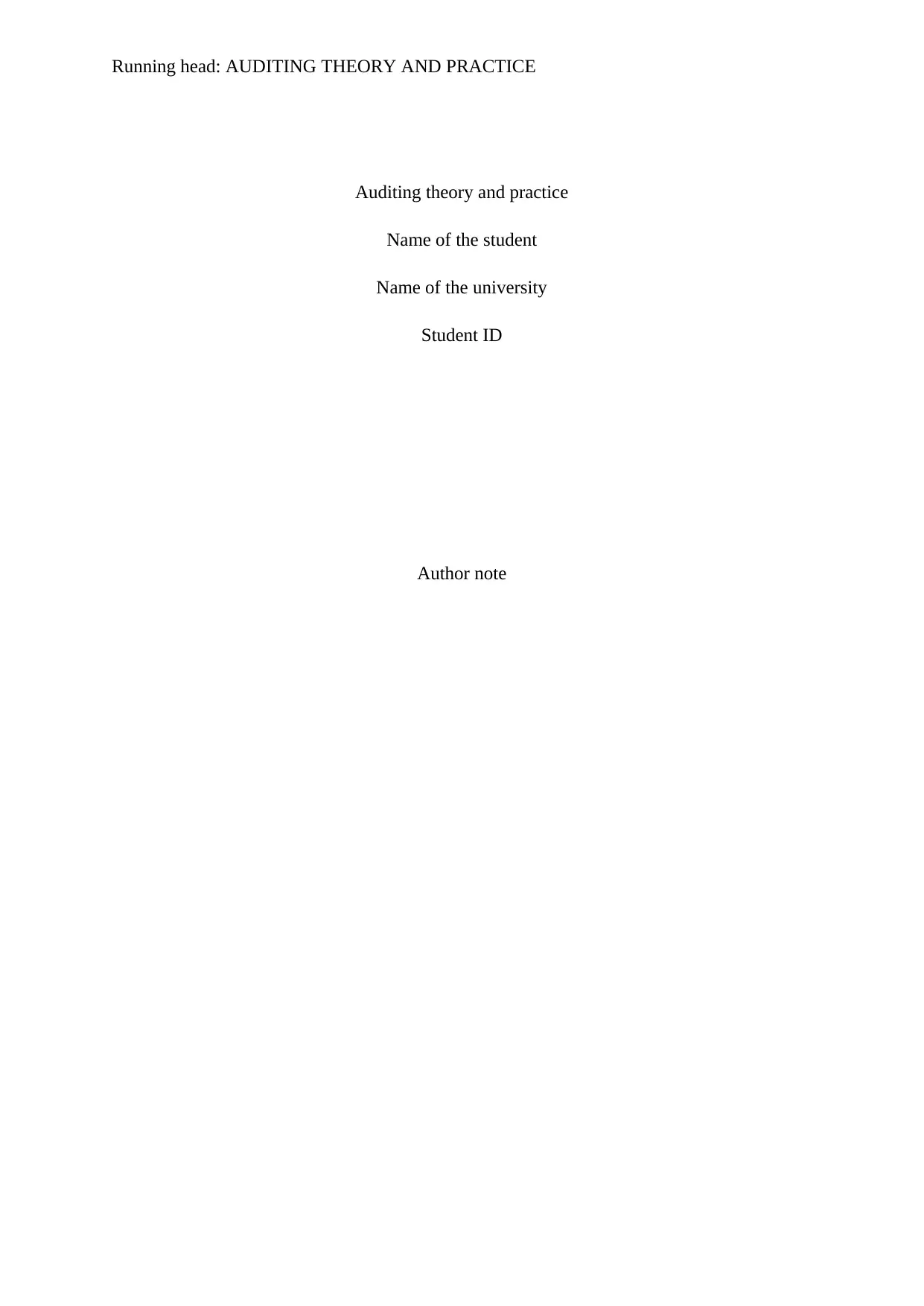
Running head: AUDITING THEORY AND PRACTICE
Auditing theory and practice
Name of the student
Name of the university
Student ID
Author note
Auditing theory and practice
Name of the student
Name of the university
Student ID
Author note
Paraphrase This Document
Need a fresh take? Get an instant paraphrase of this document with our AI Paraphraser
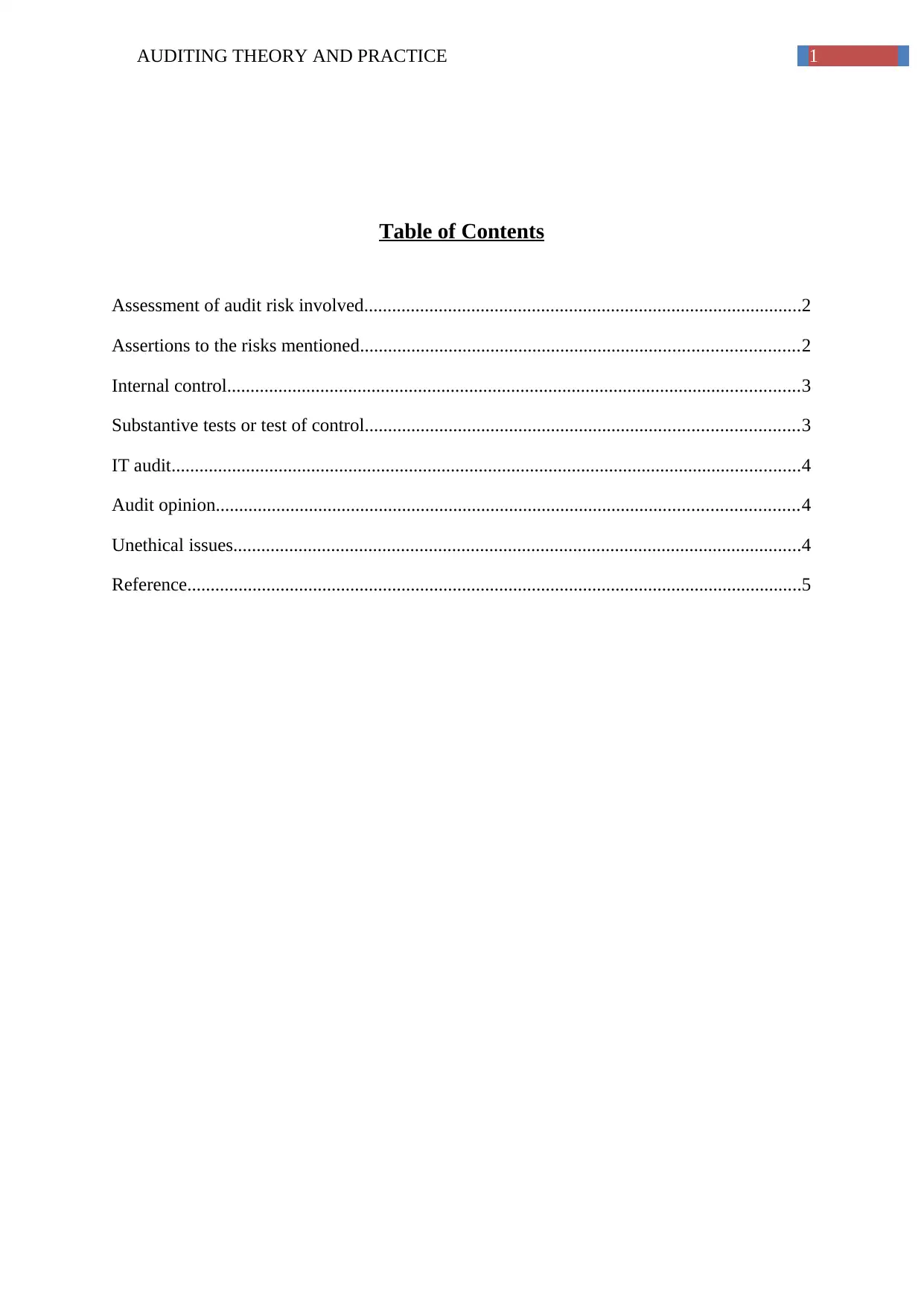
1AUDITING THEORY AND PRACTICE
Table of Contents
Assessment of audit risk involved..............................................................................................2
Assertions to the risks mentioned..............................................................................................2
Internal control...........................................................................................................................3
Substantive tests or test of control.............................................................................................3
IT audit.......................................................................................................................................4
Audit opinion.............................................................................................................................4
Unethical issues..........................................................................................................................4
Reference....................................................................................................................................5
Table of Contents
Assessment of audit risk involved..............................................................................................2
Assertions to the risks mentioned..............................................................................................2
Internal control...........................................................................................................................3
Substantive tests or test of control.............................................................................................3
IT audit.......................................................................................................................................4
Audit opinion.............................................................................................................................4
Unethical issues..........................................................................................................................4
Reference....................................................................................................................................5
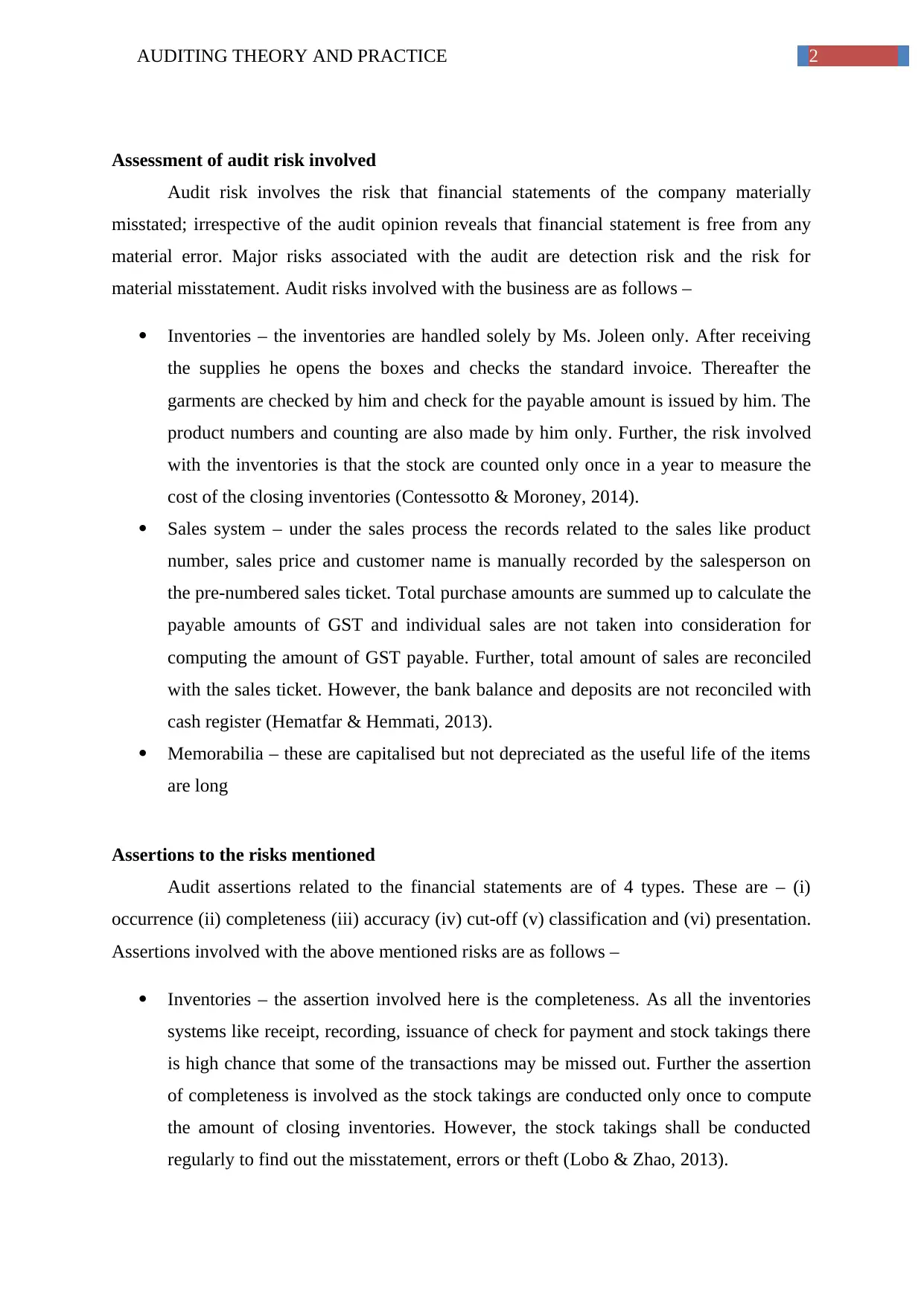
2AUDITING THEORY AND PRACTICE
Assessment of audit risk involved
Audit risk involves the risk that financial statements of the company materially
misstated; irrespective of the audit opinion reveals that financial statement is free from any
material error. Major risks associated with the audit are detection risk and the risk for
material misstatement. Audit risks involved with the business are as follows –
Inventories – the inventories are handled solely by Ms. Joleen only. After receiving
the supplies he opens the boxes and checks the standard invoice. Thereafter the
garments are checked by him and check for the payable amount is issued by him. The
product numbers and counting are also made by him only. Further, the risk involved
with the inventories is that the stock are counted only once in a year to measure the
cost of the closing inventories (Contessotto & Moroney, 2014).
Sales system – under the sales process the records related to the sales like product
number, sales price and customer name is manually recorded by the salesperson on
the pre-numbered sales ticket. Total purchase amounts are summed up to calculate the
payable amounts of GST and individual sales are not taken into consideration for
computing the amount of GST payable. Further, total amount of sales are reconciled
with the sales ticket. However, the bank balance and deposits are not reconciled with
cash register (Hematfar & Hemmati, 2013).
Memorabilia – these are capitalised but not depreciated as the useful life of the items
are long
Assertions to the risks mentioned
Audit assertions related to the financial statements are of 4 types. These are – (i)
occurrence (ii) completeness (iii) accuracy (iv) cut-off (v) classification and (vi) presentation.
Assertions involved with the above mentioned risks are as follows –
Inventories – the assertion involved here is the completeness. As all the inventories
systems like receipt, recording, issuance of check for payment and stock takings there
is high chance that some of the transactions may be missed out. Further the assertion
of completeness is involved as the stock takings are conducted only once to compute
the amount of closing inventories. However, the stock takings shall be conducted
regularly to find out the misstatement, errors or theft (Lobo & Zhao, 2013).
Assessment of audit risk involved
Audit risk involves the risk that financial statements of the company materially
misstated; irrespective of the audit opinion reveals that financial statement is free from any
material error. Major risks associated with the audit are detection risk and the risk for
material misstatement. Audit risks involved with the business are as follows –
Inventories – the inventories are handled solely by Ms. Joleen only. After receiving
the supplies he opens the boxes and checks the standard invoice. Thereafter the
garments are checked by him and check for the payable amount is issued by him. The
product numbers and counting are also made by him only. Further, the risk involved
with the inventories is that the stock are counted only once in a year to measure the
cost of the closing inventories (Contessotto & Moroney, 2014).
Sales system – under the sales process the records related to the sales like product
number, sales price and customer name is manually recorded by the salesperson on
the pre-numbered sales ticket. Total purchase amounts are summed up to calculate the
payable amounts of GST and individual sales are not taken into consideration for
computing the amount of GST payable. Further, total amount of sales are reconciled
with the sales ticket. However, the bank balance and deposits are not reconciled with
cash register (Hematfar & Hemmati, 2013).
Memorabilia – these are capitalised but not depreciated as the useful life of the items
are long
Assertions to the risks mentioned
Audit assertions related to the financial statements are of 4 types. These are – (i)
occurrence (ii) completeness (iii) accuracy (iv) cut-off (v) classification and (vi) presentation.
Assertions involved with the above mentioned risks are as follows –
Inventories – the assertion involved here is the completeness. As all the inventories
systems like receipt, recording, issuance of check for payment and stock takings there
is high chance that some of the transactions may be missed out. Further the assertion
of completeness is involved as the stock takings are conducted only once to compute
the amount of closing inventories. However, the stock takings shall be conducted
regularly to find out the misstatement, errors or theft (Lobo & Zhao, 2013).
⊘ This is a preview!⊘
Do you want full access?
Subscribe today to unlock all pages.

Trusted by 1+ million students worldwide
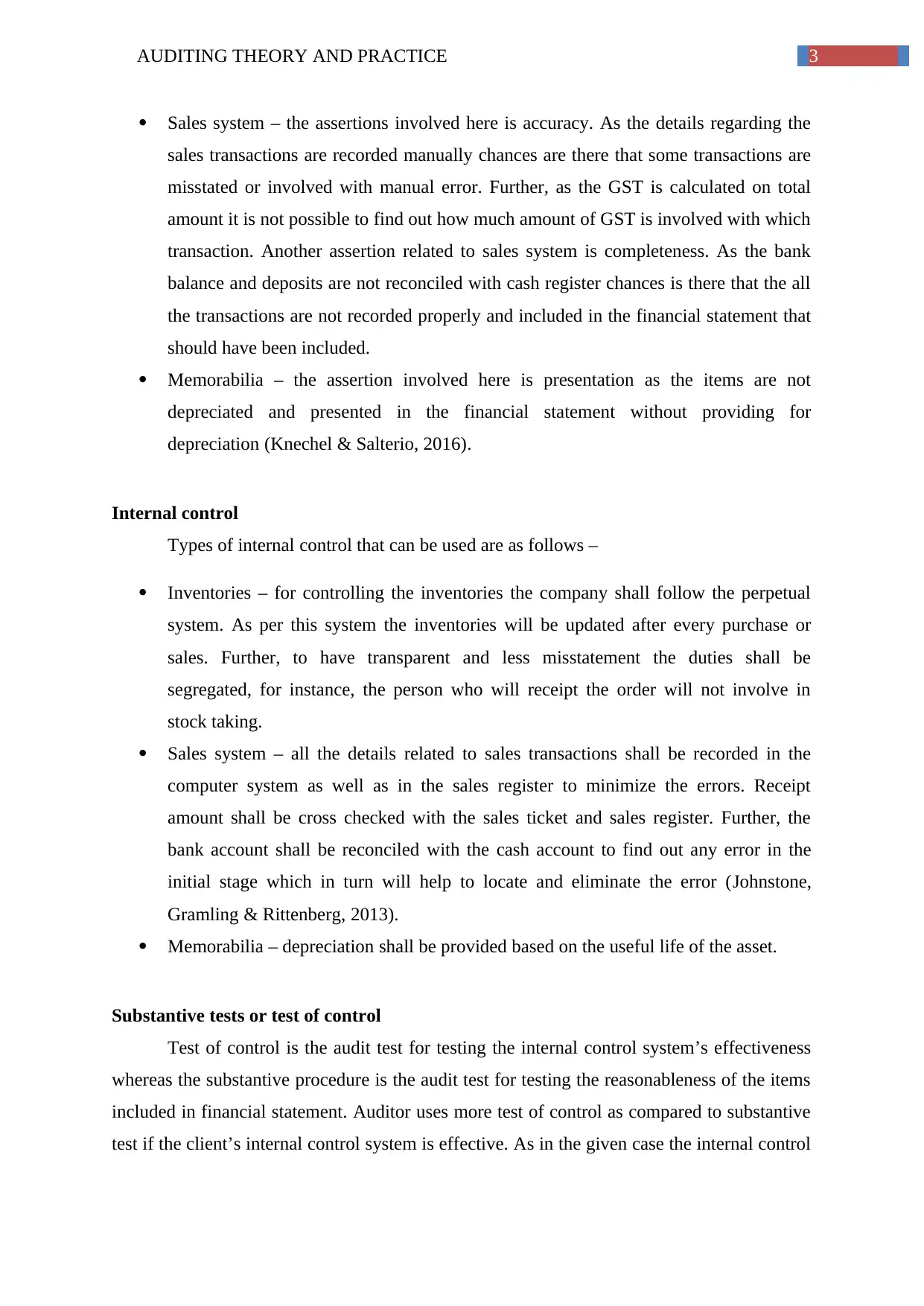
3AUDITING THEORY AND PRACTICE
Sales system – the assertions involved here is accuracy. As the details regarding the
sales transactions are recorded manually chances are there that some transactions are
misstated or involved with manual error. Further, as the GST is calculated on total
amount it is not possible to find out how much amount of GST is involved with which
transaction. Another assertion related to sales system is completeness. As the bank
balance and deposits are not reconciled with cash register chances is there that the all
the transactions are not recorded properly and included in the financial statement that
should have been included.
Memorabilia – the assertion involved here is presentation as the items are not
depreciated and presented in the financial statement without providing for
depreciation (Knechel & Salterio, 2016).
Internal control
Types of internal control that can be used are as follows –
Inventories – for controlling the inventories the company shall follow the perpetual
system. As per this system the inventories will be updated after every purchase or
sales. Further, to have transparent and less misstatement the duties shall be
segregated, for instance, the person who will receipt the order will not involve in
stock taking.
Sales system – all the details related to sales transactions shall be recorded in the
computer system as well as in the sales register to minimize the errors. Receipt
amount shall be cross checked with the sales ticket and sales register. Further, the
bank account shall be reconciled with the cash account to find out any error in the
initial stage which in turn will help to locate and eliminate the error (Johnstone,
Gramling & Rittenberg, 2013).
Memorabilia – depreciation shall be provided based on the useful life of the asset.
Substantive tests or test of control
Test of control is the audit test for testing the internal control system’s effectiveness
whereas the substantive procedure is the audit test for testing the reasonableness of the items
included in financial statement. Auditor uses more test of control as compared to substantive
test if the client’s internal control system is effective. As in the given case the internal control
Sales system – the assertions involved here is accuracy. As the details regarding the
sales transactions are recorded manually chances are there that some transactions are
misstated or involved with manual error. Further, as the GST is calculated on total
amount it is not possible to find out how much amount of GST is involved with which
transaction. Another assertion related to sales system is completeness. As the bank
balance and deposits are not reconciled with cash register chances is there that the all
the transactions are not recorded properly and included in the financial statement that
should have been included.
Memorabilia – the assertion involved here is presentation as the items are not
depreciated and presented in the financial statement without providing for
depreciation (Knechel & Salterio, 2016).
Internal control
Types of internal control that can be used are as follows –
Inventories – for controlling the inventories the company shall follow the perpetual
system. As per this system the inventories will be updated after every purchase or
sales. Further, to have transparent and less misstatement the duties shall be
segregated, for instance, the person who will receipt the order will not involve in
stock taking.
Sales system – all the details related to sales transactions shall be recorded in the
computer system as well as in the sales register to minimize the errors. Receipt
amount shall be cross checked with the sales ticket and sales register. Further, the
bank account shall be reconciled with the cash account to find out any error in the
initial stage which in turn will help to locate and eliminate the error (Johnstone,
Gramling & Rittenberg, 2013).
Memorabilia – depreciation shall be provided based on the useful life of the asset.
Substantive tests or test of control
Test of control is the audit test for testing the internal control system’s effectiveness
whereas the substantive procedure is the audit test for testing the reasonableness of the items
included in financial statement. Auditor uses more test of control as compared to substantive
test if the client’s internal control system is effective. As in the given case the internal control
Paraphrase This Document
Need a fresh take? Get an instant paraphrase of this document with our AI Paraphraser

4AUDITING THEORY AND PRACTICE
system of the company is very poor and the auditors need to test the internal control system’s
effectiveness, test of control will be appropriate in the given case (Arens et al., 2016).
IT audit
Audit in IT is important as it provides the assurance that IT systems are sufficiently
protected and delivers reliable information to the users that it is properly managed for
achieving the integrated benefits. As in the given case, Ms Joleen is involved with various
important procedures of the company and she does not possess expertise knowledge in IT she
will lack various aspects like computerised record keeping, tracking the accounting records
and following up the records prepared by the accountant Mr. Peter Baker.
Test of controls for IT will be carried out through analysing the reliability with regard
to the data generated from computer that supports the financial statement. The specific
programmes and resultant outcomes shall also be analysed. Apart from that, the auditors shall
examine adequacy of the control involved under the information system and associated
operations for assuring the effectiveness of the system (Chan & Vasarhelyi, 2018).
Audit opinion
In the given case, the modified audit opinion shall be provided as the company
significantly lacks in internal control aspect. Further, the company’s major operation part
regarding the sales and inventories are handled solely by Ms Joleen. Here non-segregation of
duties involves various risks and assertions like accuracy, completeness, errors and
misstatement. Therefore, in such case modified opinion will be issued.
Unethical issues
The major unethical issue involved in the case is that irrespective of carrying out the
business on large scale and issuing shares on regular basis the company did not registered
itself with Australian Stock exchange. Further, the customers are allowed to take merchandise
and make the payment on next day (Leung et al., 2014). However, the company may have to
suffer huge amount of loss if the customer escape with the dues.
system of the company is very poor and the auditors need to test the internal control system’s
effectiveness, test of control will be appropriate in the given case (Arens et al., 2016).
IT audit
Audit in IT is important as it provides the assurance that IT systems are sufficiently
protected and delivers reliable information to the users that it is properly managed for
achieving the integrated benefits. As in the given case, Ms Joleen is involved with various
important procedures of the company and she does not possess expertise knowledge in IT she
will lack various aspects like computerised record keeping, tracking the accounting records
and following up the records prepared by the accountant Mr. Peter Baker.
Test of controls for IT will be carried out through analysing the reliability with regard
to the data generated from computer that supports the financial statement. The specific
programmes and resultant outcomes shall also be analysed. Apart from that, the auditors shall
examine adequacy of the control involved under the information system and associated
operations for assuring the effectiveness of the system (Chan & Vasarhelyi, 2018).
Audit opinion
In the given case, the modified audit opinion shall be provided as the company
significantly lacks in internal control aspect. Further, the company’s major operation part
regarding the sales and inventories are handled solely by Ms Joleen. Here non-segregation of
duties involves various risks and assertions like accuracy, completeness, errors and
misstatement. Therefore, in such case modified opinion will be issued.
Unethical issues
The major unethical issue involved in the case is that irrespective of carrying out the
business on large scale and issuing shares on regular basis the company did not registered
itself with Australian Stock exchange. Further, the customers are allowed to take merchandise
and make the payment on next day (Leung et al., 2014). However, the company may have to
suffer huge amount of loss if the customer escape with the dues.
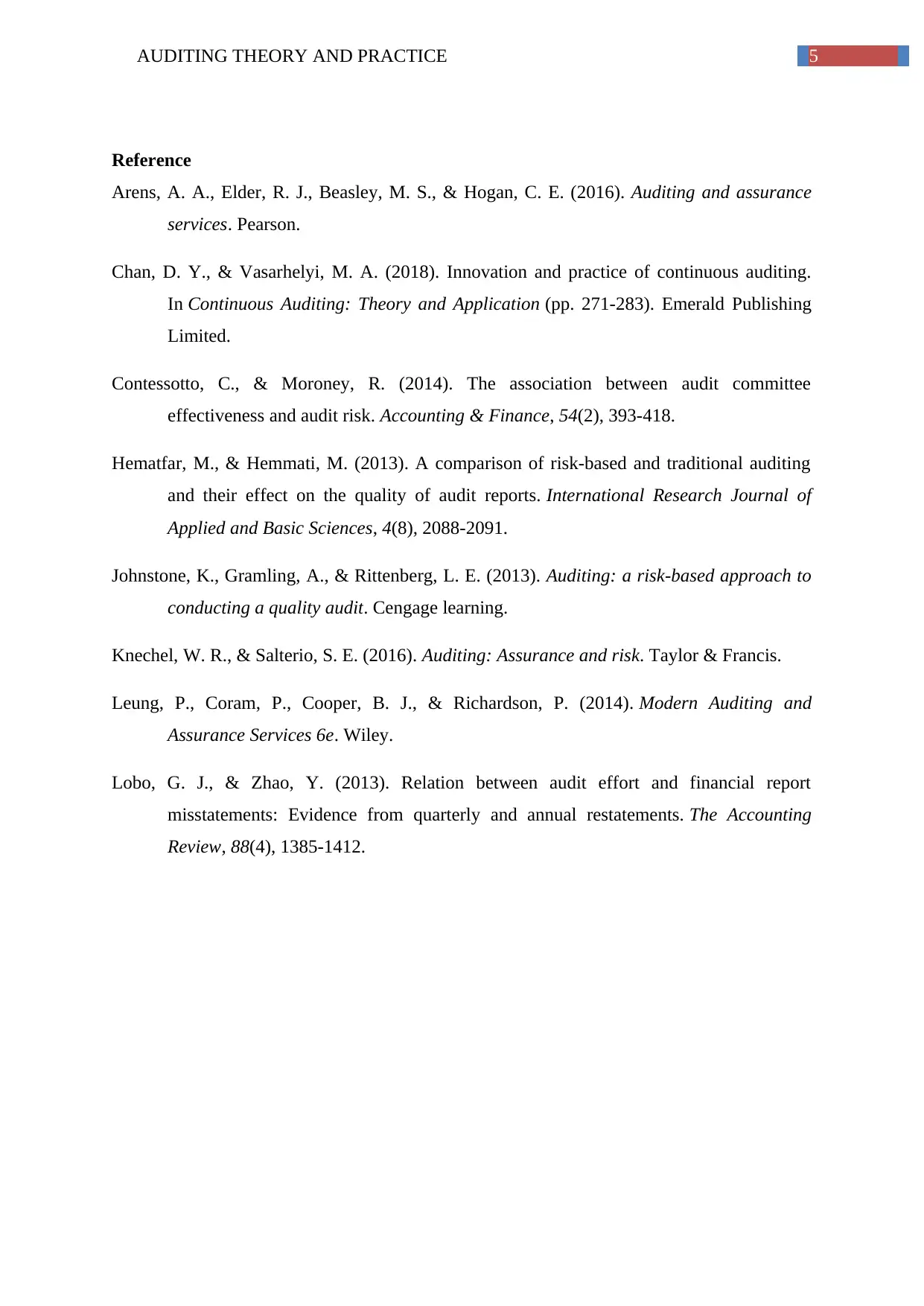
5AUDITING THEORY AND PRACTICE
Reference
Arens, A. A., Elder, R. J., Beasley, M. S., & Hogan, C. E. (2016). Auditing and assurance
services. Pearson.
Chan, D. Y., & Vasarhelyi, M. A. (2018). Innovation and practice of continuous auditing.
In Continuous Auditing: Theory and Application (pp. 271-283). Emerald Publishing
Limited.
Contessotto, C., & Moroney, R. (2014). The association between audit committee
effectiveness and audit risk. Accounting & Finance, 54(2), 393-418.
Hematfar, M., & Hemmati, M. (2013). A comparison of risk-based and traditional auditing
and their effect on the quality of audit reports. International Research Journal of
Applied and Basic Sciences, 4(8), 2088-2091.
Johnstone, K., Gramling, A., & Rittenberg, L. E. (2013). Auditing: a risk-based approach to
conducting a quality audit. Cengage learning.
Knechel, W. R., & Salterio, S. E. (2016). Auditing: Assurance and risk. Taylor & Francis.
Leung, P., Coram, P., Cooper, B. J., & Richardson, P. (2014). Modern Auditing and
Assurance Services 6e. Wiley.
Lobo, G. J., & Zhao, Y. (2013). Relation between audit effort and financial report
misstatements: Evidence from quarterly and annual restatements. The Accounting
Review, 88(4), 1385-1412.
Reference
Arens, A. A., Elder, R. J., Beasley, M. S., & Hogan, C. E. (2016). Auditing and assurance
services. Pearson.
Chan, D. Y., & Vasarhelyi, M. A. (2018). Innovation and practice of continuous auditing.
In Continuous Auditing: Theory and Application (pp. 271-283). Emerald Publishing
Limited.
Contessotto, C., & Moroney, R. (2014). The association between audit committee
effectiveness and audit risk. Accounting & Finance, 54(2), 393-418.
Hematfar, M., & Hemmati, M. (2013). A comparison of risk-based and traditional auditing
and their effect on the quality of audit reports. International Research Journal of
Applied and Basic Sciences, 4(8), 2088-2091.
Johnstone, K., Gramling, A., & Rittenberg, L. E. (2013). Auditing: a risk-based approach to
conducting a quality audit. Cengage learning.
Knechel, W. R., & Salterio, S. E. (2016). Auditing: Assurance and risk. Taylor & Francis.
Leung, P., Coram, P., Cooper, B. J., & Richardson, P. (2014). Modern Auditing and
Assurance Services 6e. Wiley.
Lobo, G. J., & Zhao, Y. (2013). Relation between audit effort and financial report
misstatements: Evidence from quarterly and annual restatements. The Accounting
Review, 88(4), 1385-1412.
⊘ This is a preview!⊘
Do you want full access?
Subscribe today to unlock all pages.

Trusted by 1+ million students worldwide
1 out of 6
Related Documents
Your All-in-One AI-Powered Toolkit for Academic Success.
+13062052269
info@desklib.com
Available 24*7 on WhatsApp / Email
![[object Object]](/_next/static/media/star-bottom.7253800d.svg)
Unlock your academic potential
© 2024 | Zucol Services PVT LTD | All rights reserved.





